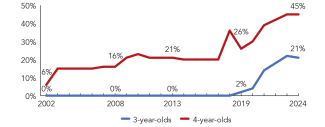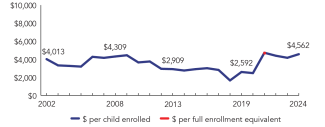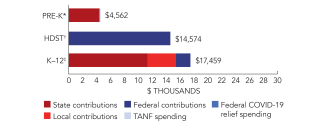
State of Preschool
Kansas
Access Rankings
Resource Rankings
Total Benchmarks Met
Overview

During the 2023-2024 school year, Kansas preschool enrolled 24,236 children, a decrease of 76 from the prior year. State spending totaled $106,427,052, and an additional $4,132,317 in TANF funds, up $9,357,190 (9%), adjusted for inflation, since last year. State spending per child (including TANF) equaled $4,562 in 2023-2024, up $399 from 2022-2023, adjusted for inflation. Kansas met 6 of 10 quality standards benchmarks.
What's New

In February 2024, the Kansas State Board of Education and the Kansas Children’s Cabinet and Trust Fund approved the updated Kansas Early Learning Standards. This was a two-year process that included early childhood experts from across the birth to kindergarten continuum and had representatives from childcare, Head Start, school districts, 2- and 4-year colleges, consultants, and trainers.
In August 2024, the Kansas Children’s Cabinet approved the 2024 All In For Kansas Kids Strategic Plan. Building on the progress of recent years and in response to the 2024 All In For Kansas Kids Needs Assessment, this plan charts a path forward for the entire Kansas early childhood ecosystem.
Background
Kansas supports two funding streams for state prekindergarten. The first, established in 1998, is the State Pre-K 4 Year Old At-Risk Program (more recently renamed the Preschool-Aged At-Risk Program). The second is the Kansas Preschool Pilot (KPP), first offered in the 2006-2007 school year. Both funding streams are administered through the Kansas State Department of Education (KSDE) and are reported together due to their similar standards and overlapping enrollment.
Between the two funding streams, funding was available in all 286 school districts in Kansas, and 2022-2023 marks the second year that 3-year-olds are included in this report.
In 2015, KSBE announced a new vision for education in the state: Kansas leads the world in the success of each student. Kindergarten Readiness is one identified metric to track progress toward this goal. In 2018, the KSDE was internally restructured to increase emphasis and capacity around early childhood. Beginning in 2020, the Kansans Can Star Recognition Program gives districts the opportunity to apply for recognition in the qualitative Board Outcome areas, including Kindergarten Readiness. This will provide an opportunity to measure and drive quality improvements at the community level.
Preschool Offered by Public School Districts
Access
Resources
| Total state pre-K spending | $110,559,369 |
| Local match required? | No |
| State Head Start spending | $0 |
| State spending per child enrolled | $4,562 |
| All reported spending per child enrolled* | $4,562 |

*Pre-K programs may receive additional funds from federal or local sources that are not included in this figure. †Head Start per-child spending includes funding only for 3- and 4-year-olds. ‡K–12 expenditures include capital spending as well as current operating expenditures.
Kansas Quality Standards Checklist
| Policy | Requirement | Benchmark | Meets Benchmark? |
|---|---|---|---|
For more information about the benchmarks, see the Executive Summary and the Roadmap to State pages. | 6benchmarks met | ||
| Early Learning & Development Standards Benchmark | Comprehensive, aligned, supported, culturally sensitive | Comprehensive, aligned, supported, culturally sensitive | |
| Curriculum Supports Benchmark | Approval process & supports | Approval process & supports | |
| Teacher Degree Benchmark | BA | BA | |
| Teacher Specialized Training Benchmark | ECE, CD, Elem. Ed. | Specializing in pre-K | |
| Assistant Teacher Degree Benchmark | Other | CDA or equivalent | |
| Staff Professional Development Benchmark | 15 hours/year; PD plans (teachers only); Coaching (some teachers) | For teachers & assistants: At least 15 hours/year; individual PD plans; coaching | |
| Maximum Class Size Benchmark | 20 (3- & 4-year-olds) | 20 or lower | |
| Staff to Child Ratio Benchmark | 1:10 (3- & 4-year-olds) | 1:10 or better | |
| Screening & Referral Benchmark | Vision, hearing, health & more | Vision, hearing & health screenings; & referral | |
| Continuous Quality Improvement System Benchmark | None | Structured classroom observations; data used for program improvement | |
